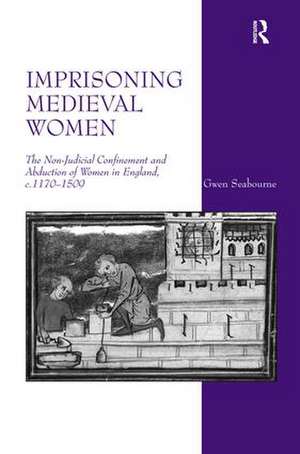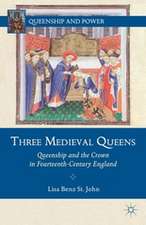Imprisoning Medieval Women: The Non-Judicial Confinement and Abduction of Women in England, c.1170-1509
Autor Gwen Seabourneen Limba Engleză Hardback – 13 iun 2011
Preț: 1051.64 lei
Preț vechi: 1282.48 lei
-18% Nou
Puncte Express: 1577
Preț estimativ în valută:
201.41€ • 207.51$ • 168.72£
201.41€ • 207.51$ • 168.72£
Carte tipărită la comandă
Livrare economică 22 februarie-08 martie
Preluare comenzi: 021 569.72.76
Specificații
ISBN-13: 9781409417880
ISBN-10: 1409417883
Pagini: 238
Dimensiuni: 156 x 234 x 14 mm
Greutate: 0.59 kg
Ediția:1
Editura: Taylor & Francis
Colecția Routledge
Locul publicării:Oxford, United Kingdom
ISBN-10: 1409417883
Pagini: 238
Dimensiuni: 156 x 234 x 14 mm
Greutate: 0.59 kg
Ediția:1
Editura: Taylor & Francis
Colecția Routledge
Locul publicării:Oxford, United Kingdom
Notă biografică
Gwen Seabourne is Senior Lecturer in the School of Law, University of Bristol, UK. She specialises in medieval legal history, and has written on medieval crime, economic regulation and medieval women.
Recenzii
'Seabourne’s meticulous study examines the variety of creative ways the medieval English subjected women to abduction and confinement, focusing especially on women’s experiences of confinement and how those experiences altered over time.' Journal of British Studies '... this is an excellent study of the situations of confinement that medieval women all too frequently experienced. It is based on an impressive range of sources and it is well written and carefully argued. ... the wealth of detail relating to women’s experience makes this book an original and important contribution to the burgeoning field of medieval captivity and imprisonment.' Parergon '... this book generates a number of thought-provoking questions.' Speculum
Cuprins
Introduction; Part I By Royal Power and Command: Maidens (and Other Women) in Towers; Chapter 1 Confinement of Women in War and Armed Conflict; Chapter 2 Other Species of ‘Garde’: Royal Wardship and ‘Idiocy’ Guardianship; Chapter 3 ‘A Dreary and Solitary Place’ or ‘Honourable Captivity’?; Part II Wrongful Imprisonment and Abduction: Legal Responses and their Limits; Chapter 4 ‘Countless Ravishments of Women’? Legislation and Other Royal Initiatives; Chapter 5 Common Law; Chapter 6 Escaping the Confines of the Common Law; Chapter 7 ‘Not Averse to the Arrangement’? Allegations of Collusion and Consent; Part III Other Roles; Chapter 8 Agency and Contagion: Further Aspects of Women’s Participation; conclusion Conclusion;
Descriere
This study of the confinement of women highlights the disparity in regulation concerning male and female imprisonment in the middle ages, and gives a useful perspective on the nature of medieval law, its scope and limitations, and its interaction with royal power and prerogative. It examines situations in which women might be imprisoned without formal accusation of trial; how social status, national allegiance and stage of life affected the chances of imprisonment; the relevant legal rules and norms; the extent to which legal and constitutional developments in medieval England affected women's amenability to confinement; and how women were involved in situations of non-judicial imprisonment, aside from themselves being prisoners.












